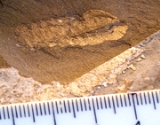
Sidneyia
Encyclopedia
Sidneyia is an extinct arthropod
known from fossil
s found in the Cambrian
-age Burgess Shale
formation of British Columbia
.
s and trilobite
s.
Sidneyia was discovered in 1910 during the first day of Charles Walcott's exploration of the Burgess Shale. He named it after his elder son, Sidney, who had helped to locate the site and collect the specimen. The species name, Sidneyia inexpectans, means "Sidney's discovery".
About 200 specimens have been documented.
Arthropod
An arthropod is an invertebrate animal having an exoskeleton , a segmented body, and jointed appendages. Arthropods are members of the phylum Arthropoda , and include the insects, arachnids, crustaceans, and others...
known from fossil
Fossil
Fossils are the preserved remains or traces of animals , plants, and other organisms from the remote past...
s found in the Cambrian
Cambrian
The Cambrian is the first geological period of the Paleozoic Era, lasting from Mya ; it is succeeded by the Ordovician. Its subdivisions, and indeed its base, are somewhat in flux. The period was established by Adam Sedgwick, who named it after Cambria, the Latin name for Wales, where Britain's...
-age Burgess Shale
Burgess Shale
The Burgess Shale Formation, located in the Canadian Rockies of British Columbia, is one of the world's most celebrated fossil fields, and the best of its kind. It is famous for the exceptional preservation of the soft parts of its fossils...
formation of British Columbia
British Columbia
British Columbia is the westernmost of Canada's provinces and is known for its natural beauty, as reflected in its Latin motto, Splendor sine occasu . Its name was chosen by Queen Victoria in 1858...
.
General description
Sidneyia ranged from 2 to 5 in (5.1 to 12.7 ) in length and is one of the largest arthropods found at the site. It is thought to have been a benthic carnivore that walked along the sea floor in search of hard-shelled prey. Gut contents have revealed that Sidneyia fed on hyolithids (molluscs) and other small crustaceanCrustacean
Crustaceans form a very large group of arthropods, usually treated as a subphylum, which includes such familiar animals as crabs, lobsters, crayfish, shrimp, krill and barnacles. The 50,000 described species range in size from Stygotantulus stocki at , to the Japanese spider crab with a leg span...
s and trilobite
Trilobite
Trilobites are a well-known fossil group of extinct marine arthropods that form the class Trilobita. The first appearance of trilobites in the fossil record defines the base of the Atdabanian stage of the Early Cambrian period , and they flourished throughout the lower Paleozoic era before...
s.
Sidneyia was discovered in 1910 during the first day of Charles Walcott's exploration of the Burgess Shale. He named it after his elder son, Sidney, who had helped to locate the site and collect the specimen. The species name, Sidneyia inexpectans, means "Sidney's discovery".
About 200 specimens have been documented.

